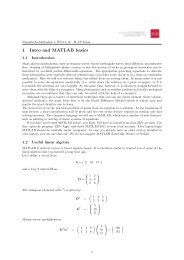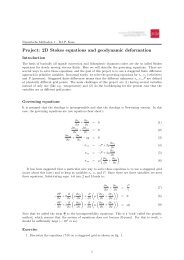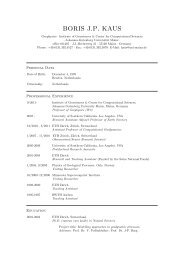8 Advection equations and the art of numerical modeling
8 Advection equations and the art of numerical modeling
8 Advection equations and the art of numerical modeling
- No tags were found...
Create successful ePaper yourself
Turn your PDF publications into a flip-book with our unique Google optimized e-Paper software.
Numerische Methoden 1 – B.J.P. Kaus8 <strong>Advection</strong> <strong>equations</strong> <strong>and</strong> <strong>the</strong> <strong>art</strong> <strong>of</strong> <strong>numerical</strong> <strong>modeling</strong>S<strong>of</strong>ar we mainly focussed on diffusion equation in a non-moving domain. This is maybe relevant for <strong>the</strong>case <strong>of</strong> a dike intrusion or for a lithosphere which remains undeformed. However <strong>the</strong>re are also caseswhere material moves. An example is a plume rising through a convecting mantle. The plume is hot<strong>and</strong> hence its density is low compared to <strong>the</strong> colder mantle around it. The hot material rises with agiven velocity (when term-projects are finished we will have codes that give us those velocities for agiven density distribution). If <strong>the</strong> <strong>numerical</strong> grid remains fixed in <strong>the</strong> background, <strong>the</strong> hot temperaturesshould be moved to different gridpoints (see fig. 1 for an illustration <strong>of</strong> this effect).Figure 1: Snapshots <strong>of</strong> a bottom heated <strong>the</strong>rmal convection model with a Rayleigh-number <strong>of</strong> 5 × 10 5<strong>and</strong> constant viscosity (no internal heating). Temperature is advected through a fixed (eulerian) grid(circles) with a velocity (arrows) that is computed with a Stokes solver.Ma<strong>the</strong>matically, <strong>the</strong> temperature equation gets an additional term <strong>and</strong> in 1-D <strong>the</strong> diffusion-advectionequation becomes (see equation cheat sheet)( )∂Tρc p∂t + v ∂Tx = ∂ (k ∂T )(1)∂x ∂x ∂xor in 2-D( )∂Tρc p∂t + v ∂Tx∂x + v ∂Tz = ∂ (k ∂T )+ ∂ (k ∂T )∂z ∂x ∂x ∂z ∂zwhere v x , v z are velocities in x-,respectively z-direction.If diffusion is absent (i.e. k = 0), <strong>the</strong> advection <strong>equations</strong> are(2)∂T∂t + v ∂Tx∂x = 0 (3)<strong>and</strong>∂T∂t + v ∂Tx∂x + v ∂Tz∂z = 0 (4)These <strong>equations</strong> should also be solved if you want to compute <strong>the</strong> settling <strong>of</strong> a heavy p<strong>art</strong>icle in a fluid,or in wea<strong>the</strong>r prediction codes. In <strong>the</strong> current lecture we’re going to look at some options on how tosolve <strong>the</strong>se <strong>equations</strong> with a finite difference scheme on a fixed grid. Even though <strong>the</strong> <strong>equations</strong> are fairlysimple, it is far from simple to solve <strong>the</strong>m accurately. If not done carefully, you’ll end up with strong<strong>numerical</strong> <strong>art</strong>ifacts such as wiggles <strong>and</strong> <strong>numerical</strong> diffusion.1
Numerische Methoden 1 – B.J.P. Kaus% advection_central_1D%clear allnx = 201;W = 40; % width <strong>of</strong> domainVel = -4; % velocitysigma = 1;Ampl = 2;nt = 500; % number <strong>of</strong> timestepsdt = 1e-2;dx = W/(nx-1);x = 0:dx:W;% Initial gaussian T-pr<strong>of</strong>ilexc = 20;T = Ampl*exp(-(x-xc).^2/sigma^2);% VelocityVx = ones(1,nx)*Vel;% Central finite difference discretizationfor itime=1:nt% central fin. difffor ix=2:nx-1Tnew(ix) = ??endTnew(1) = T(1);Tnew(nx) = T(nx);T = Tnew;time = itime*dt;% Analytical solution for this caseT_anal = Ampl*exp(-(x-xc-time*Vel).^2/sigma^2);figure(1),clf, plot(x,T,x,T_anal),drawnowendlegend(’Numerical’,’Analytical’)Figure 2: MATLAB script to be used with exercise 1.8.1 FTCS methodIn a 1-D case <strong>the</strong> simplest way to discretize equation 3 is by employing a central finite difference scheme(also called <strong>the</strong> forward-time, central space or FTCS scheme):T n+1i− Tin∆t= −v x,iT n i+1 − T n i−12∆x(5)8.1.1 Exercise 1• Program <strong>the</strong> FTCS method in <strong>the</strong> code <strong>of</strong> figure 2 <strong>and</strong> watch what happens. Change <strong>the</strong> sign <strong>of</strong><strong>the</strong> velocity. Change <strong>the</strong> timestep <strong>and</strong> gridspacing <strong>and</strong> compute <strong>the</strong> nondimensional parameterα = |v x |∆t/∆x. When do unstable results occur?As you saw from <strong>the</strong> exercise, <strong>the</strong> FTCS method does not work... In fact it is a nice example <strong>of</strong> ascheme that looks nice (<strong>and</strong> logical!) on paper, but sucks [you can actually ma<strong>the</strong>matically prove thisby a socalled von Neuman stability analysis, if you’re interested you should read chapter 5 <strong>of</strong> MarcSpiegelman’s script on <strong>the</strong> course webpage; it’s related to <strong>the</strong> fact that this scheme produces antidiffusion,which is <strong>numerical</strong>ly instable].8.2 Lax methodin <strong>the</strong> time-Some day, long ago, <strong>the</strong>re was a guy called Lax <strong>and</strong> he thought: well let’s replace <strong>the</strong> Tinderivative <strong>of</strong> equation 5 with (Ti+1 n + T i−1 n )/2. The resulting equation isT n+1i − (Ti+1 n + T i−1 n )/2 Ti+1 n = −v − T i−1nx,i∆t2∆x(6)2
Numerische Methoden 1 – B.J.P. Kaus8.2.1 Exercise 2• Program <strong>the</strong> Lax method by modifying <strong>the</strong> script <strong>of</strong> <strong>the</strong> last exercise. Play with different velocities<strong>and</strong> compute <strong>the</strong> Courant number α, which is given by <strong>the</strong> following equation:α =∆x∆t|v x |(7)Is <strong>the</strong> <strong>numerical</strong> scheme stable for all Courant numbers?As you saw from <strong>the</strong> exercise <strong>the</strong> Lax method doesn’t blow up, but does have a lot <strong>of</strong> <strong>numerical</strong> diffusion.So it’s an improvement but it’s still not perfect, since you may loose <strong>the</strong> plumes <strong>of</strong> figure 1 aroundmid-mantle purely due to <strong>numerical</strong> diffusion (<strong>and</strong> than you’ll probably find some fancy geochemicalexplanation for this...). I hope that you also slowly st<strong>art</strong> to see that <strong>numerical</strong> <strong>modeling</strong> is a bit <strong>of</strong> an<strong>art</strong>...8.3 Upwind schemeThe next scheme that people came up with is <strong>the</strong> so-called upwind scheme.difference scheme depends on <strong>the</strong> sign <strong>of</strong> <strong>the</strong> velocity:Here, <strong>the</strong> spatial finiteT n+1i− Tin∆t= −v x,i{ Tni −T n i−1∆x, if v x,i > 0T n i+1 −T n i∆x, if v x,i < 0(8)8.3.1 Exercise 3• Program <strong>the</strong> upwind scheme method. Play with different velocities <strong>and</strong> compute <strong>the</strong> Courantnumber α Is <strong>the</strong> <strong>numerical</strong> scheme stable for all Courant numbers?Also <strong>the</strong> upwind scheme suffers from <strong>numerical</strong> diffusion.S<strong>of</strong>ar we employed explicit discretizations. You’re probably wondering whe<strong>the</strong>r implicit discretizationswill save us again this time. Bad news: doesn’t work (try if you want). So we have to come upwith something else.8.4 Staggered LeapfrogThe explicit discretizations discussed s<strong>of</strong>ar were second order accurate in time, but only first order inspace. We can also come up with a scheme that is second order in time <strong>and</strong> spaceT n+1i− T n−12∆t= −v x,iT n i+1 − T n i−12∆x<strong>the</strong> difficulty in this scheme is that we’ll have to store two timestep levels: both T n−1 <strong>and</strong> T n (but i’msure you’ll manage).(9)8.4.1 Exercise 4• Program <strong>the</strong> staggered leapfrog method (assume that at <strong>the</strong> first timestep T n−1 = T n ). Playaround with different values <strong>of</strong> <strong>the</strong> Courant number α. Also make <strong>the</strong> width <strong>of</strong> <strong>the</strong> gaussian curvesmaller.The staggered leapfrog method works quite well regarding <strong>the</strong> amplitude <strong>and</strong> wavespeed as long asα is close to one. If however α
Numerische Methoden 1 – B.J.P. Kaus8.5 MPDATAThis is a technique that is frequently applied in (older) mantle convection codes. The basic idea is basedon an idea <strong>of</strong> Smolarkiewicz <strong>and</strong> is basically a modification <strong>of</strong> <strong>the</strong> upwind scheme, where some iterativecorrections are applied. The results are quite ok. However it’s somewhat more complicated to implement(<strong>the</strong> system that’s solved is actually nonlinear <strong>and</strong> requires iterations, which we did not discuss yet).Moreover we still have a restriction on <strong>the</strong> timestep (given by <strong>the</strong> Courant criterium). For this reasonwe won’t go into detail here (see Spiegelman’s lecture notes, chapter 5 if you’re interested).8.6 Marker-based advectionSo what we want is a scheme that doesn’t blow up, has only small <strong>numerical</strong> diffusion <strong>and</strong> that isnot limited by <strong>the</strong> Courant criterium. The simplest manner in doing this is to use a marker-based ortracer-based advection scheme, which -as a nice side-effect- is something you will anyways need to modelgeodynamic case studies (as soon as you finished <strong>the</strong> Stokes solver in one <strong>of</strong> <strong>the</strong> next classes).8.6.1 Basic ideaThe basic idea <strong>of</strong> a marker-based advection method that you add some marker in your code (typicallymany more than <strong>the</strong> number <strong>of</strong> <strong>numerical</strong> gridpoints). A marker is a point, which has coordinates ([x]in 1D, [x, y] in 2D) <strong>and</strong> a given temperature T . You define your initial temperature field at each marker.Marker-based advection, than requires <strong>the</strong> following steps:1. Interpolate velocity from nodal points to marker. In matlab, <strong>the</strong> comm<strong>and</strong> interp1 (in 1D) orinterp2 (in 2D) can be used to do this.2. Compute <strong>the</strong> new marker location with x n+1 (p) = x n (p) + ∆tv n x (p) (where v n x (p) is <strong>the</strong> velocity atmarker p).3. Check for markers that are outside <strong>the</strong> boundary <strong>of</strong> <strong>the</strong> computational model.4. Interpolate temperature from markers to nodal points. If nodal points have <strong>the</strong> coordinates x(i),x(i+1), x(i+2),... a possibility to do this is to find all markers between x(i-1/2) <strong>and</strong> x(i+1/2) (use’find’), <strong>and</strong> compute <strong>the</strong> average temperature among those p<strong>art</strong>icles (use ’mean’ to do this). Moresophisticated schemes involve distance-based averaging (see lecture notes <strong>of</strong> Taras Gerya).5. Go back to step 1.8.6.2 Exercise 5• Program <strong>the</strong> marker-based advection scheme in 1D. Assume that your mesh is periodic, whichmeans that if x marker > L, you set x marker = x marker − L (assuming that your mesh goes from 0to L.8.7 2D advectionMarker-based advections schemes are ra<strong>the</strong>r powerful which is why we’re going to implement in 2D.Assume that velocity is given byv x (x, z) = z (10)v z (x, z) = −x (11)Moreover, assume that <strong>the</strong> initial temperature distribution is gaussian <strong>and</strong> given by(((x + 0.25) 2 + z 2) )T (x, z) = 2 exp0.1 2with x ∈ [−0.5, 0.5], z ∈ [−0.5, 0.5].(12)4
Numerische Methoden 1 – B.J.P. Kaus8.7.1 Exercise 7• Program advection in 2D using a marker-based advection scheme.The marker-based advection scheme discussed here is first-order accurate in space <strong>and</strong> time. Inreality, you should use a second order or fourth order accurate scheme in space, combined with a firstorder or second-order accurate time-stepping algorithm. Such higher order schemes are known as 2 nd - or4 th -order accurate Runga-Kutta schemes, <strong>and</strong> are described in more detail in <strong>the</strong> lecture notes <strong>of</strong> TarasGerya, in <strong>the</strong> Numerical Recipes textbook, <strong>and</strong> in Wikipedia. Feel free to implement <strong>the</strong>m in <strong>the</strong> codeabove.8.8 <strong>Advection</strong> <strong>and</strong> diffusion: operator splittingMarker-based advection methods are among <strong>the</strong> best methods for advection dominated problems. Wealso learned how to solve <strong>the</strong> diffusion equation in 1-D <strong>and</strong> 2-D. In geodynamics, we <strong>of</strong>ten want tosolve <strong>the</strong> coupled advection-diffusion equation, which is given by equation 1 in 1-D <strong>and</strong> by equation 2in 2-D. We can solve this pretty easily by taking <strong>the</strong> equation ap<strong>art</strong> <strong>and</strong> by computing <strong>the</strong> advectionp<strong>art</strong> separately from <strong>the</strong> diffusion p<strong>art</strong>. This is called operator-splitting, <strong>and</strong> what’s done in 1-D is <strong>the</strong>following. First solve <strong>the</strong> advection equation˜T n+1 − T n∆t+ v x∂T∂x = 0 (13)for example by using a semi-lagrangian advection scheme. Then solve <strong>the</strong> diffusion equation∂ρc ˜T(p∂t = ∂ k ∂ ˜T)+ Q (14)∂x ∂x<strong>and</strong> you’re done (note that I assumed that Q is spatially constant; if not you should consider to slightlyimprove <strong>the</strong> advection scheme by introducing source terms) . In 2D <strong>the</strong> scheme is identical (but you’llhave to find your old 2D codes...).8.8.1 Exercise 8• Program diffusion-advection in 2D using <strong>the</strong> marker-based advection scheme coupled with an implicit2D diffusion code (from last week’s exercise). Base your code on <strong>the</strong> script <strong>of</strong> figure ??.5






